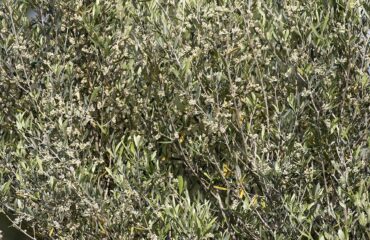Ocimum basilicum, commonly known as Basil, is a tender annual herb renowned for its aromatic leaves and essential role in culinary traditions worldwide. Native to tropical regions of central Africa and Southeast Asia, Basil is prized for its sweet, spicy flavor and is a staple in Mediterranean, Thai, and Italian cuisines. The plant has soft, green leaves and can produce small white or purple flowers if allowed to bloom. Basil varieties range from sweet basil with its large, glossy leaves to more exotic types like Thai basil and purple basil. Typically, Basil grows to a height of 12-24 inches (30-60 cm) and spreads about the same width, making it an ideal choice for garden beds, containers, and windowsill herb gardens.
Preferred Growing Conditions:
- Soil Type: Prefers well-drained, fertile soil; thrives in a mix of loamy soil enriched with compost or organic matter.
- Sunlight: Requires full sun; needs at least 6-8 hours of direct sunlight daily for optimal growth and flavor development.
- Temperature: Hardy in USDA zones 10-11 as a perennial outdoors, but commonly grown as an annual in cooler climates; prefers temperatures between 70-85°F (21-29°C) and is sensitive to frost.
- Water Needs: Moderate; requires regular watering to keep the soil consistently moist but not waterlogged. Basil prefers slightly drier conditions once established.
Ocimum Basilicum (Basil) Propagation Methods:
1. Seed Propagation:
Seed propagation is the most common and effective method for growing Basil, allowing for the production of numerous plants with ease.
- Seed Collection and Preparation:
- Collect seeds from mature flower heads after they have dried and turned brown.
- Gently rub the flower heads to release the small black seeds.
- Clean and dry the seeds for a few days before planting or store them in a cool, dry place for future use.
- Sowing Techniques:
- Sow seeds indoors 6-8 weeks before the last expected frost date or directly in the garden after the danger of frost has passed.
- Fill seed trays or small pots with a light, well-draining seed-starting mix.
- Scatter the seeds thinly over the surface and cover lightly with a thin layer of soil or vermiculite.
- Water gently to settle the soil and place the trays in a bright, warm location with temperatures around 70-75°F (21-24°C).
- Germination Requirements:
- Seeds typically germinate within 5-10 days under optimal conditions.
- Keep the soil consistently moist but not waterlogged during germination.
- Once seedlings emerge, provide bright, indirect light and maintain consistent moisture.
- When seedlings have developed their first true leaves and are sturdy enough to handle, thin them to ensure adequate spacing or transplant them into individual pots.
2. Stem Cuttings:
Propagating Basil from stem cuttings is a fast and reliable method, especially for creating new plants from existing ones without the need for seeds.
- Types of Cuttings:
- Use soft, non-flowering shoots taken from healthy, mature plants.
- Preparation:
- Select healthy, non-flowering shoots and cut 4-6 inch sections just below a leaf node.
- Remove the lower leaves, leaving only the top few pairs of leaves on the cutting.
- Rooting in Water:
- Place the cuttings in a glass of water, ensuring the leaf nodes are submerged.
- Place the glass in a bright, indirect light location.
- Change the water every few days to keep it fresh and clear.
- Roots should begin to form within 7-10 days.
- Rooting in Soil:
- Alternatively, insert the cuttings directly into a well-draining potting mix, such as a blend of peat and perlite.
- Water lightly to settle the soil and place the pot in a bright, indirect light location.
- Cover the pot with a plastic bag or place in a propagation tray with a clear lid to maintain high humidity.
- Transplanting:
- Once roots are well-established and new growth appears, transplant the rooted cuttings into individual pots or directly into the garden.
- Gradually acclimate the new plants to outdoor conditions if they were started indoors.
3. Division:
Division is not commonly used for Basil as it is an annual and does not typically form clumps suitable for division. However, in rare cases where Basil grows densely and develops multiple stems, this method can be used.
- Timing:
- The best time for division is in early spring before new growth begins or in early autumn after the active growing season.
- Method:
- Carefully dig up the plant and gently separate the root ball into smaller sections, ensuring each division has several shoots and a portion of the root system.
- Use a sharp knife or garden spade to divide the root ball if necessary.
- Remove any dead or damaged roots and foliage.
- Replanting:
- Replant the divisions immediately in prepared pots or garden beds filled with well-draining soil.
- Plant at the same depth as the original clump, spacing divisions to allow room for growth.
- Water thoroughly to settle the soil around the roots.
- Care After Division:
- Keep the newly planted divisions well-watered as they establish.
- Place the pots in a bright, indirect light location or a sunny spot in the garden.
- Protect from strong drafts and sudden temperature changes during the initial recovery period.
4. Layering:
Layering is not typically used for Basil due to its annual growth habit and the nature of its stems. Instead, sticking to seeds and cuttings is more practical and efficient.
Care for Newly Propagated Plants:
- Place new plants in a location with full sun to encourage vigorous growth and optimal flavor development.
- Water regularly to keep the soil consistently moist but not waterlogged.
- Feed with a balanced, water-soluble fertilizer every 4-6 weeks during the growing season to promote healthy growth.
- Pinch back the growing tips regularly to encourage bushier growth and prevent flowering, which can cause the leaves to become bitter.
- Protect from strong drafts and sudden temperature changes to prevent stress.
Common Challenges and Solutions:
- Powdery Mildew: Ensure good air circulation around plants and avoid overhead watering. Treat with fungicides if necessary.
- Aphids and Spider Mites: Monitor for common pests and treat infestations with insecticidal soap or neem oil.
- Leaf Yellowing: This can indicate overwatering, underwatering, or nutrient deficiencies. Adjust care accordingly.
Additional Tips:
- Harvest leaves regularly to encourage new growth and prevent the plant from becoming leggy.
- Avoid allowing Basil to flower unless you plan to collect seeds, as flowering can reduce the flavor quality of the leaves.
- Use pots with drainage holes to prevent water accumulation and root rot when growing Basil in containers.
- Basil can be grown indoors on a sunny windowsill or under grow lights to provide fresh herbs year-round.
Conclusion:
Propagating Basil offers a rewarding opportunity to grow this versatile and aromatic herb in your garden, kitchen, or windowsill. Whether you choose to start from seeds, use stem cuttings, or divide larger plants, with proper care and attention, Basil will thrive and provide you with a continuous supply of fresh, flavorful leaves for culinary use.
Share this article


